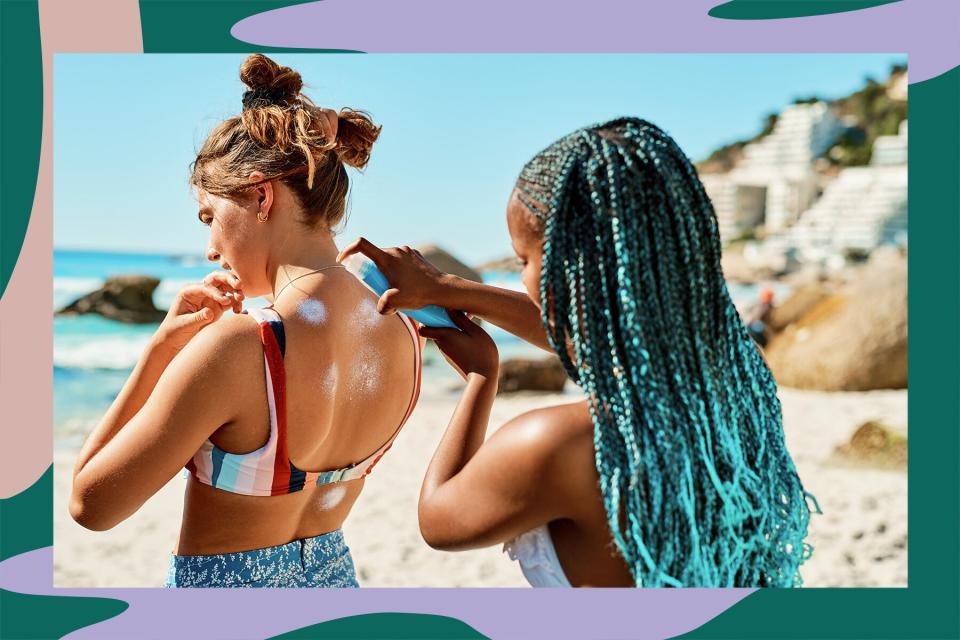Hold Up, Is 'Reef-Safe Sunscreen' Actually Just BS?

Katleho Seisa, Getty Images
Despite what you may have heard, you can't fix split ends, and shaving your hair won't make it grow back thicker. In Myth Busters, we debunk common beauty misconceptions and set the record straight.
Buying skincare products with the words "clean" or "eco-friendly" on the labels has a way of making us feel better about our purchases. However, many marketings terms aren't regulated by the FDA, which makes it confusing to understand skincare products and what they're good for. Case in point: Reef-safe sunscreens.
There's no denying that sunscreen is one of the most important products that should be included in your daily routine—yes, cloudy days included. However, ever since places like Hawaii and Palau banned the use and selling of over-the-counter sunscreen with oxybenzone and octinoxate, "reef-safe sunscreen" has been a buzzy topic—and the claim is showing up on more labels than ever before.
However, the science behind "reef-safe" claims isn't so black and white, and a lot of companies are using this wording without substantial evidence. We spoke to three industry experts and dived into studies so we could break down what reef-safe sunscreen is, how it affects the coral reef, what other factors are damaging it, and what else we should know about the matter. Before we dive deep into the facts about reef-safe sunscreens, though, it's important to understand how sunscreens work and their potential impact on coral reefs.
How does sunscreen protect the skin?
Sunscreen can be divided into two categories: physical (also known as mineral) and chemical. Chemical sunscreens are formulated with ingredients such as oxybenzone, avobenzone, octocrylene, and octinoxate. Mineral sunscreens are most commonly formulated with zinc oxide and titanium dioxide.
While many believe that chemical and physical sunscreens work differently in protecting the skin against UV rays, Krupa Koestline, a clean cosmetic chemist, explains that they work similarly by absorbing UV rays into the skin and turning that energy into heat. Physical sunscreens will also reflect and scatter around five to ten percent of incoming UV rays, providing a protective barrier on the skin. Mineral sunscreens are thought to be safer for marine ecology, which is why some regions around the world have taken legal action against the use of chemical sunscreens. But why?

Wavebreakmedia, Getty Images
How does sunscreen affect the coral reef?
"Sunscreen pollution can cause several ecological impacts," says Dr. Craig Downs, executive director of Haereticus Environmental Laboratory, a lab dedicated to studying coral reefs and other environmental habitats. Of these impacts is coral bleaching, which he says causes the coral to turn white and eventually die.
Coral reefs are important because they offer protection and a home to a wide variety of marine life. David Petrillo, cosmetic chemist and founder of skincare company Perfect Image, says that when sunscreen chemicals end up in the ocean, they can act as endocrine disruptors and interfere with the hormonal systems of the organisms that inhabit the coral reefs.
A study done by Dr. Downs shows that oxybenzone acts like estrogen, so it can cause male fish to turn into female fish, which can result in a population that is not able to reproduce. Ecological pathologies, such as the ones described, can lead to the extinction of not only coral reefs, but other marine life as well. According to Dr. Downs, sunscreen pollution is often localized in areas where tourism is popular. The amount of sunscreen it takes to cause harm to a reef, though, is dependent upon the duration of exposure, but many studies have shown effects on coral reefs at varying concentrations.
What else is harming the coral reef?
The biggest threat to the coral reef is climate change. According to the National Ocean Service, this leads to warmer oceans, rising sea levels, altered ocean currents, and ocean acidification caused by increased CO2 levels. All of this causes coral bleaching, smothering of the coral, destruction of existing reefs, and decreased coral growth and structural integrity. Additionally, the NOS says that overfishing can deplete key reef species and damage coral habitat. Dr. Downs adds that the combination of pollution from fertilizers and sewage pose a threat to and damage coral reefs, as well.

Unsplash
So, is "reef-safe" a legitimate claim?
While sunscreen pollution is a real concern, all of the experts we interviewed agree that the claim "reef-safe sunscreen" is not regulated enough and that there isn't enough consistent scientific evidence that proves one type of sunscreen is better for the environment. Plus, the above mentioned problems, such as overfishing and climate change, are more likely to be destroying the coral reef than your FDA-approved sunscreen. The truth is, chemical sunscreens have been demonized for their potentially harmful effects, but some studies show zinc oxide can cause coral bleaching, too. Not to mention, the process of mining zinc has also been shown to cause harmful environmental effects, such as increased pollution.
Unfortunately, many companies use the term "reef-safe sunscreen" as a marketing tactic to appear more eco-friendly and scare consumers into choosing their products, when in reality, there is no standard way of testing to prove the reef safety of sunscreen, explains Koestline. "While brands have developed their own testing methods to put these claims on their packaging, they're not all validated methods," she says. So, while there should be more studies that look into the correlation between sunscreen and ocean safety, there are concrete studies that prove that environmental factors and human activity are much more harmful.
What sunscreen should you use?
Ultimately, it's all about finding what works best for you and your skin type. Petrillo recommends searching for a formula with SPF 30 or higher and Koestline adds that you should look for the words "broad-spectrum protection" on the label to ensure you're protecting yourself from both UVA and UVB rays. When in doubt, do more research into the companies you're purchasing from. "Educating consumers is a powerful force in getting companies to be responsible, transparent, and encourage them to be better," says Dr. Downs.

 Yahoo Finance
Yahoo Finance 